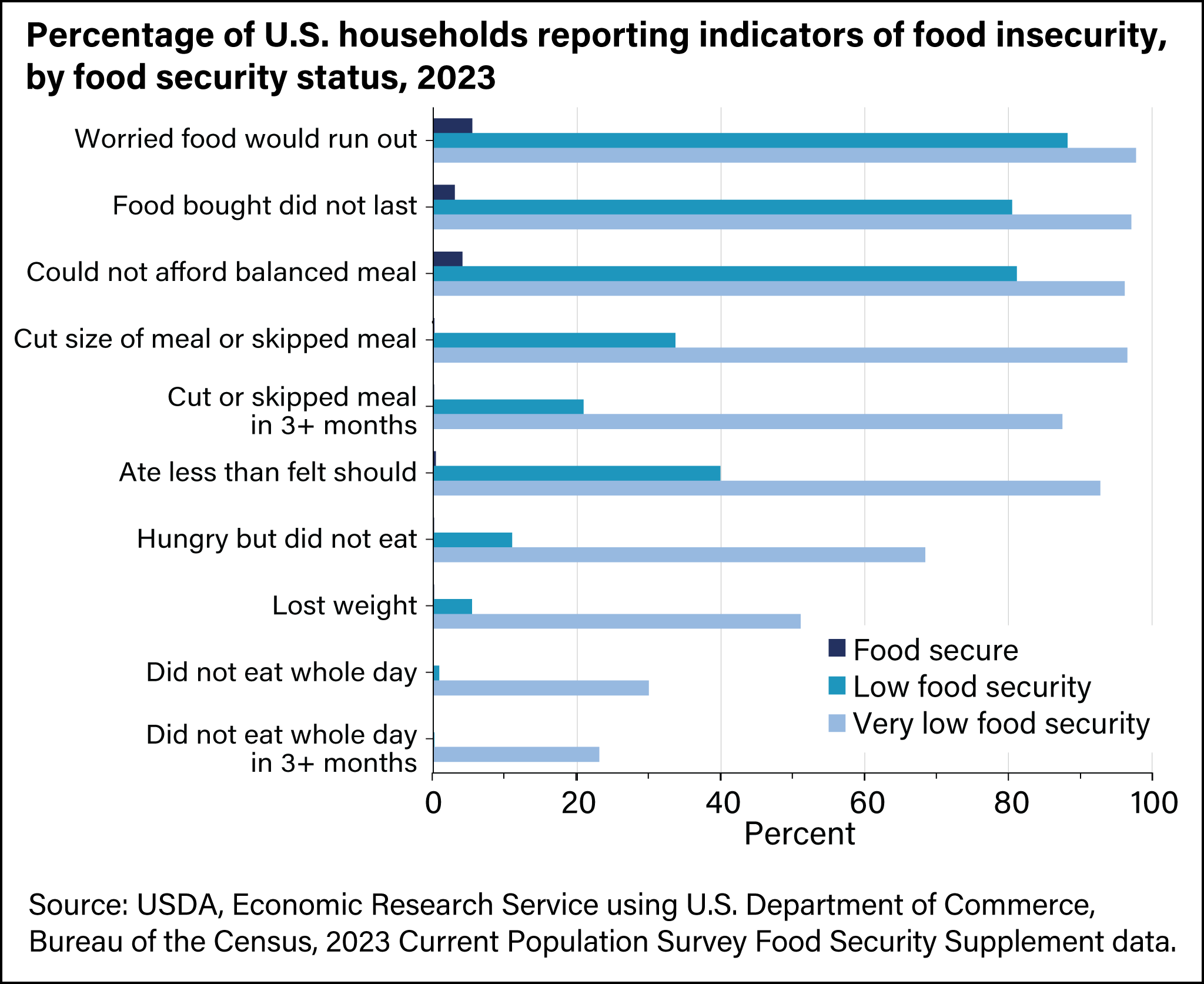This page provides the following information:
- Ranges of Food Security and Food Insecurity
- CNSTAT Review and Recommendations
- Characteristics of Households with Very Low Food Security
Return to Overview
Ranges of Food Security and Food Insecurity
In 2006, USDA introduced new language to describe ranges of severity of food insecurity. USDA made these changes in response to recommendations of an expert panel convened at USDA's request by the Committee on National Statistics (CNSTAT) of the National Academies. Although new labels were introduced, the methods used to assess households' food security remained unchanged, so statistics for 2005 to now are directly comparable with those for earlier years. The following labels define ranges of food security:
Food Security
- High food security (old label = Food security): no reported indications of food-access problems or limitations.
- Marginal food security (old label = Food security): one or two reported indications—typically of anxiety over food sufficiency or shortage of food in the house. Little or no indication of changes in diets or food intake.
Food Insecurity
- Low food security (old label = Food insecurity without hunger): reports of reduced quality, variety, or desirability of diet. Little or no indication of reduced food intake.
- Very low food security (old label = Food insecurity with hunger): reports of multiple indications of disrupted eating patterns and reduced food intake.
CNSTAT Review and Recommendations
USDA requested the review by CNSTAT to ensure that the measurement methods USDA uses to assess households' access—or lack of access—to adequate food and the language used to describe those conditions are conceptually and operationally sound and that they convey relevant information to policy officials and the public. The CNSTAT panel that conducted this study included economists, sociologists, nutritionists, statisticians, and other researchers. One of the central issues the panel addressed was whether the concepts and definitions underlying the measurement methods—especially the concept and definition of hunger and the relationship between hunger and food insecurity—were appropriate for the policy context in which food security statistics are used.
The CNSTAT panel:
- Recommended that USDA continue to measure and monitor food insecurity regularly in a household survey.
- Affirmed that the general methodology used to measure food insecurity is appropriate.
- Suggested several ways to refine the methodology (contingent on additional research). USDA, ERS published technical research reports on potential refinements and continues to conduct research on these issues. See:
The CNSTAT panel also recommended that USDA make a clear and explicit distinction between food insecurity and hunger:
- Food insecurity—the condition assessed in the food security survey and represented in USDA food security reports—is a household-level economic and social condition of limited or uncertain access to adequate food.
- Hunger is an individual-level physiological condition that may result from food insecurity.
The word "hunger," the panel stated in its final report, "...should refer to a potential consequence of food insecurity that, because of prolonged, involuntary lack of food, results in discomfort, illness, weakness, or pain that goes beyond the usual uneasy sensation." To measure hunger in this sense would require collecting more detailed and extensive information on physiological experiences of individual household members than could be accomplished effectively in the Current Population Survey (CPS). The panel recommended, therefore, that new methods be developed to measure hunger and that a national assessment of hunger be conducted using an appropriate survey of individuals rather than a survey of households.
The CNSTAT panel also recommended that USDA consider alternative labels to convey the severity of food insecurity without using the word "hunger," since hunger is not adequately assessed in the food security survey. USDA concurred and introduced the labels "low food security" and "very low food security" in 2006.
For more information on CNSTAT Recommendations...
Characteristics of Households with Very Low Food Security
Conditions reported by households with very low food security are compared with those reported by food-secure households and by households with low (but not very low) food security in the following chart:

Download chart data in Excel format
The defining characteristic of very low food security is that—at times during the year—food intake of household members is reduced and their normal eating patterns are disrupted because the household lacks money and other resources for food. Very low food security is characterized in terms of the conditions that households in this category typically reported in the annual survey. In 2023:
- 98 percent reported having worried their food would run out before they had money to buy more.
- 97 percent reported the food they bought just did not last, and they did not have money to get more.
- 96 percent reported they could not afford to eat balanced meals.
- 97 percent reported an adult had cut the size of meals or skipped meals because there was not enough money for food; 88 percent reported this had occurred in 3 or more months.
- 93 percent reported they had eaten less than they felt they should because there was not enough money for food.
- 68 percent reported they had been hungry but did not eat because they could not afford enough food.
- 51 percent reported having lost weight because they did not have enough money for food.
- 30 percent reported an adult did not eat for a whole day because there was not enough money for food; 23 percent reported this had occurred in 3 or more months.
All households without children that were classified as having very low food security reported at least 6 of these conditions, and most households with very low food security (69 percent) reported 7 or more food-insecure conditions. Food-insecure conditions in households with children followed a similar pattern.
Return to Overview
